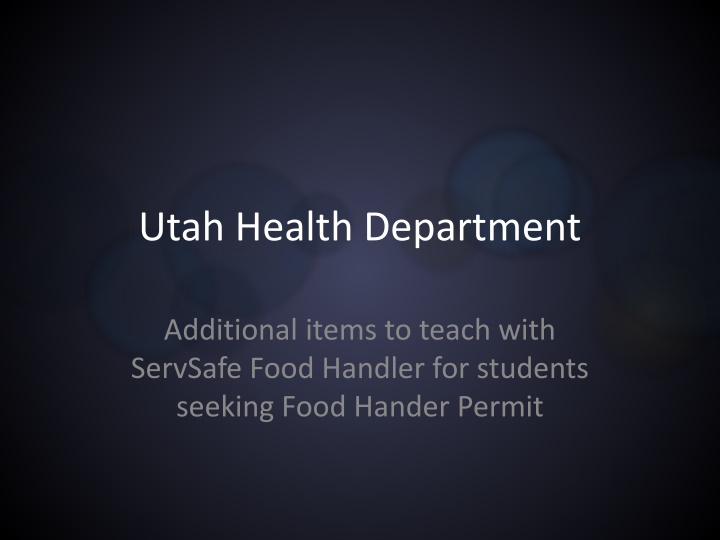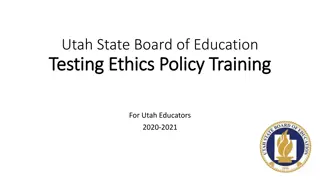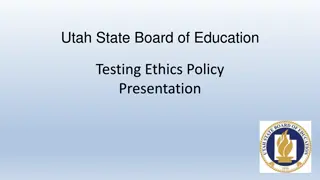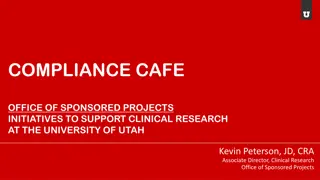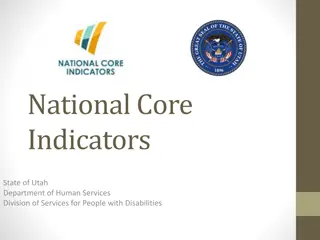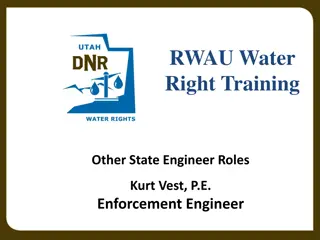Utah Health Department
Understanding how microorganisms can contaminate food, identifying high-risk populations, recognizing common foodborne illnesses, and implementing proper hygiene practices are essential for food handlers seeking permits in Utah. This comprehensive guide covers critical topics such as food safety hazards, handwashing techniques, reporting procedures for wounds, and guidelines for consuming food and beverages in designated areas.
Download Presentation

Please find below an Image/Link to download the presentation.
The content on the website is provided AS IS for your information and personal use only. It may not be sold, licensed, or shared on other websites without obtaining consent from the author.If you encounter any issues during the download, it is possible that the publisher has removed the file from their server.
You are allowed to download the files provided on this website for personal or commercial use, subject to the condition that they are used lawfully. All files are the property of their respective owners.
The content on the website is provided AS IS for your information and personal use only. It may not be sold, licensed, or shared on other websites without obtaining consent from the author.
E N D
Presentation Transcript
Utah Health Department Additional items to teach with ServSafe Food Handler for students seeking Food Hander Permit
How Food Becomes Unsafe Caused by Microorganisms tiny forms of like so small you can t see, taste or smell. Microorganisms include bacteria, viruses, parasites, fungi & mycotoxins. Growth is affected by 6 conditions: Food, Acidity, Temperature, Time, Oxygen & Moisture (FAT TOM) Time and Temperature are most easily controlled. To control bacterial growth in TCS food, minimize the time the food is in the danger zone. Some bacteria produces toxins and spores these may not be destroyed by normal cooking temperatures.
High Risk Populations Those at a higher risk for getting a foodborne illness include: Preschool-age children Elderly People with compromised immune systems
Foodborne Illness FDA has identified 5 pathogens that are highly contagious and can cause server illness: Salmonella Typhi Escherichia coli (E-coli) Shigella Hepatitis A Norovirus
Report Infected Wounds Always tell your manager if you have an infected lesion on your hands or wrists, unless covered by a finger cot and glove. Cover wounds on the arm with an impermeable cover such as a bandage. It must be completely covered.
How and When to Wash Your Hands Double hand washing is required when using the restroom. Employees must wash their hands in the restroom and wash them a second time before returning to food handling.
Cover Hand Wounds A hand cut or sore must be cleaned, bandaged, covered with a finger cot and a glove to present contamination. Any wound not covered, must be reported to a manager.
Where you Can Eat, Drink, Smoke and Chew Gum or Tobacco Eating, drinking, chewing gum or tobacco should be away from food prep areas. Smoking is only permitted outdoors at least 25 feet away from any entrance.
Date Marking When date marking food, remember that ready-to-eat TCS foods (foods greatly affected by time and temperature) may be held for 7 days if kept at 41F or lower.
Holding Food without Temperature Control Cold Food may be held without temperature control for up to 6 hours if the following conditions are met: The food is held at 41F or lower before removing from refrigeration. The food is labeled with discard time (6 hours after removed from refrigeration) Food temperature does not exceed 70F. Sold, served or discarded within 6 hours
Holding Food without Temperature Control Hot food may be held without temperature control for up to 4 hours if you met these conditions: Food is held at 135F or higher before removing it from temperature control. The food is labeled with a discard time (4 hours after removal from temperature control). The hot food must be sold, served or discarded within four hours.
Cooking TCS Foods Shell eggs for immediate service must be cooked to 145F Shell eggs that will be hot-held for service must be cooked to 155F Stuffed foods must be cooked to 165F
Cooking Requirements for Specific Types of Food Once the correct temperature has been reached, you must hold the food at this temperature for a specific amount of time. Roasts cooked to lower temperatures must maintain those temperatures for a longer period of time to ensure safety.
Chemical Sanitizing Three common types of chemical sanitizers Chlorine 50-99 parts per million (ppm) Iodine 12.5-25 ppm Quats varies, follow directions Effectiveness determined by concentration, temperature, contact time, water hardness and pH. Follow directions
Dishwasher Operation Check temperature, pressure, sanitizer levels and concentration. Use test strips to check sanitizer concentration on chemical sanitizing machines. Follow directions
Approved Suppliers Food must be purchased from approved, reputable suppliers.
